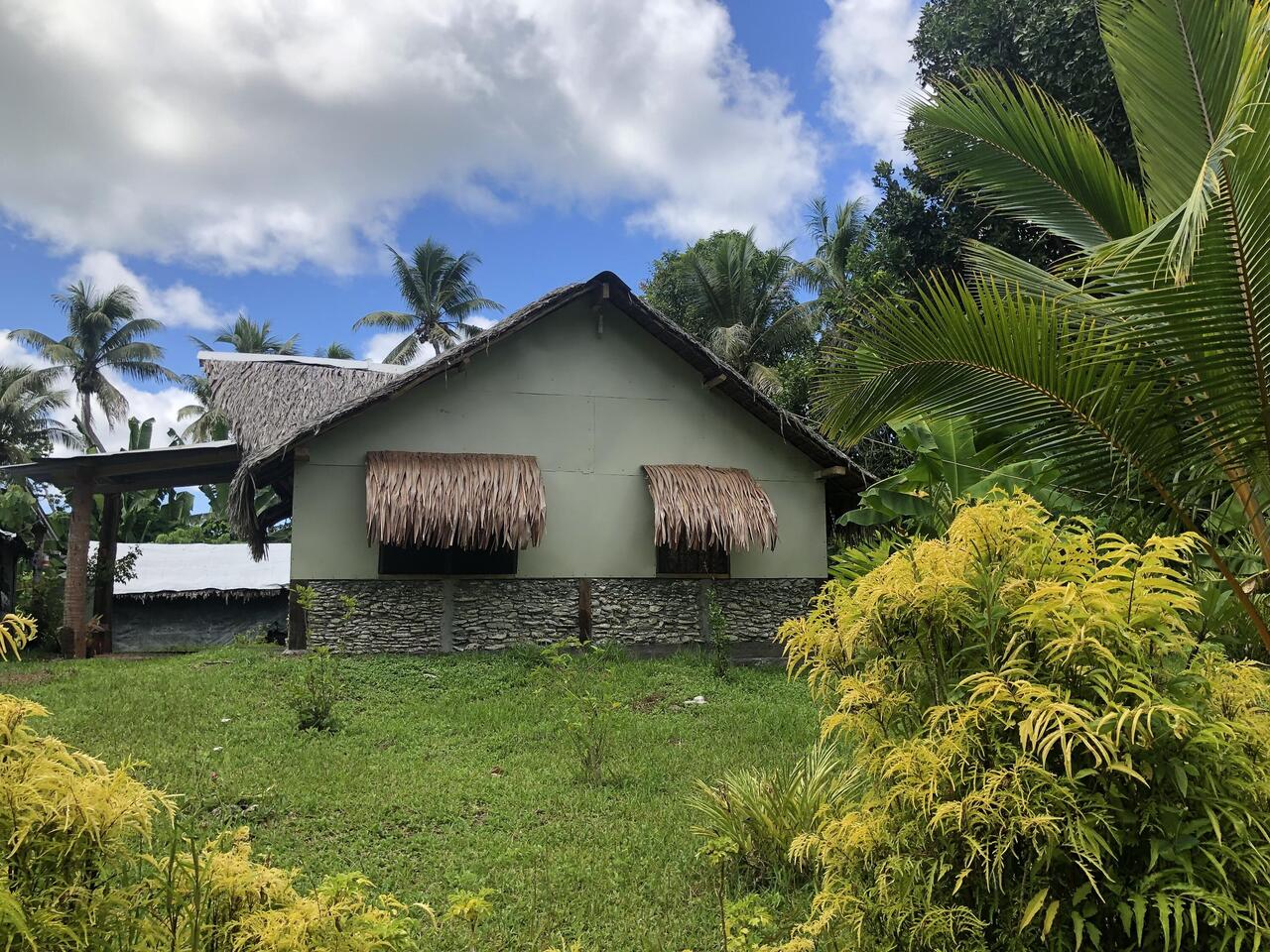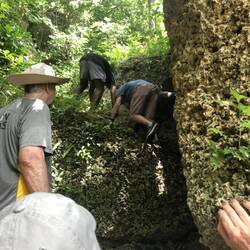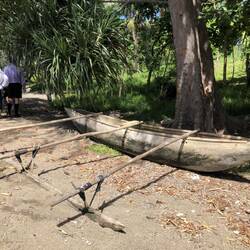Savusavu, Fiji
 March 10, 2020 in Fiji ⋅ 🌧 82 °F
March 10, 2020 in Fiji ⋅ 🌧 82 °F
Another unscheduled stop for us, and it turned out to be one of our favorites. This is an “off the beaten path” island. Lush, green, craggy mountains surround the beautiful, calm bay.
The flora along the quiet roadside is vibrant and colorful, the people greet us with huge smiles and cry out “bula” as a welcome. We would even hear people say it from inside their houses as we walked by.
Jeff and I decided to be on our own today. We took a taxi a few miles to a beach and snorkeled and swam for a couple of hours. It was sunny and gorgeous out, with big, puffy clouds and crystal clear waters. We saw some nice coral and lots of colorful fish. We like to just hang in the water over a rock complex for quite a while. After a bit, the action starts to happen and all the fish come out, zipping around like people in town going about their business. Jeff and I agreed that our favorite fish are the brilliant cobalt blue fish that are about
2” long and their gloriously turquoise counterparts
that are just a little smaller. The colors and patterning of the fish are magnificent and it’s hard to tear yourself away from such special world.
After soaking up the quiet beauty of, basically, our own private beach, we decided to walk back to town along the quiet road to catch the tender back to the ship. This was just great until it started to rain. One thing that we’ve learned is that rain in the tropics is like no rain we have known. You can see it coming from a distance and it comes down in buckets! We were able to wait it out in a cute bus stop shelter and got back to the ship tired and happy and just a little wet.
One more stop in Fiji tomorrow before continuing on.Read more
Lautoka, Fiji
 March 11, 2020 in Fiji ⋅ 🌧 82 °F
March 11, 2020 in Fiji ⋅ 🌧 82 °F
Lautoka is our last stop in Fiji. It is the “sugar city” as that is it’s primary industry.
It was pouring rain this morning. Jeff and I booked a tour that had several stops, but the best was the Garden of the Sleeping Giant. This was an orchid garden that simply took our breaths away.Read more
Port Vila, Vanuatu
 March 13, 2020 in Vanuatu ⋅ ⛅ 86 °F
March 13, 2020 in Vanuatu ⋅ ⛅ 86 °F
Today we are docked in wild and wonderful Vanuatu. At 7:30 this morning, it was already 90 degrees and probably 95% humidity.
We had signed up for a “bushwalk” which sounded like “fun” (we call that the F word).
It was truly amazing. It was an opportunity for 10 of us to get away from the beaches and the resorts and see what real life is like on a remote island in a country like Vanuatu.
Vanuatu is made up of 80 islands with a couple of larger cities scattered throughout. It is a country that has about 90-95% unemployment. Their main income source is tourism. We were allowed in today, but I’m sure it was a difficult decision to turn away another ship carrying 3000 passengers for fear of Coronavirus. They remain untouched so far, but introduction of the virus would be devastating to them.
We drove about 30 minutes to a rough path and went on our way through the jungle. The heat was oppressive and I instantly realized that my shower and the semi-cute outfit that I had donned that morning were pointless. Within minutes my shirt was soaked, not only from sweating, but from wiping the sweat dripping off my face. We saw many interesting plants and the sky was beautifully blue with puffy clouds. We passed a women dressed more heavily than I would have been and carrying a fur jacket. I guess heat is all relative. We walked along some open jungle paths, some narrower, enclosed paths, some beach areas filled with hand-hewn fishing boats and did a rock scramble. The expedition experience on this cruise is new, and we saw it here! Usually, walks are described by saying “you walk 200 meters, or need to navigate a couple of steps onto the bus”. This was more climbing than I’ve done! We had two strong local men that helped us, but it was still a challenge. Everyone was a good sport, cheering each other on, and giving a good yell when reaching the top.
Something that we found most interesting was that the houses and homesteads were beautifully tended, if very simple. The roofs are thatched and many have vegetable gardens-people tend to be self-sufficient here due to the high unemployment rate.
The lawns are gorgeous, all done with stringtrimmers. I asked about the pristine nature of all the homesteads and was told it was a cultural expectation. Their is a chief for each area who assigns certain pieces of ground to various individuals and helps maintain the order.
Another shower after the hike, and still another shower after getting caught in a deluge of rain when we went back into town in the afternoon.
In any case, I am super clean and had a great walk that afforded us guilt-free eating and drinking for dinner!Read more
In the Coral Sea
 March 16, 2020, Coral Sea ⋅ 🌧 75 °F
March 16, 2020, Coral Sea ⋅ 🌧 75 °F
As we are all aware, the Coronavirus is quickly becoming a global disaster. Many people around the world are suffering from loss and sickness.
We are merely being inconvenienced. Our cruise was canceled this morning and although things didn’t turn out quite as we expected, it is certainly not the tragedy that many people are experiencing.
We were turned away from our last 2 ports. There has also been a cyclone roaring down the length of the Coral Sea that stretches between our last stop in Vanuatu and where we are headed in Australia. Did we really need any more drama? Our captain enacted a plan of moving as fast as possible to cross in front of the cyclone and arrive in Brisbane (an unscheduled stop).
We did indeed cross in front of the cyclone (wow, these seas are rough!!!), but we have been instructed to go directly to Sydney ahead of the Australian government closing Australia’s ports.
Our cruise has been cut short by 7 weeks, but many passengers had another 11 weeks to go.
Everyone is anxious and the staff is overworked trying to figure everything out.
Jeff and I have flights to go home on the 18th through Honolulu. We will self-quarantine after traveling for 2 weeks.
Having said all this, we’ve had a fabulous time, have met some interesting people, seen incredible sites and have done a good job of keeping each other from spiraling out of control the past few days (thank goodness we take turns!)
They always say that travel is an adventure, and we definitely agree with that! Uncertainties have escalated this entire trip and it sounds like we are returning to a different world than the one we left just about 2 months ago.Read more

Franz RosenboomThanks for the Blog, take care, have a save travel back home and god bless you.
Sydney, Australia
 March 19, 2020, Tasman Sea ⋅ ☀️ 72 °F
March 19, 2020, Tasman Sea ⋅ ☀️ 72 °F
Sorry for the lack of communication, but I had trouble uploading in the middle of the ocean, but we are back with you.
We sailed into Sydney Harbor 2 days ago, and of course, are unable to leave the ship. Luckily, we had some stunning views of the harbor (the prettiest I’ve ever seen), and the city, which was pretty spectacular at night.
I believe the last time I wrote, Jeff and I had plane tickets for the 18th. Obviously, those didn’t work since we were still at anchor then. Jeff stayed up all night waiting in line for a “chat” space to change our tickets. We had 987 people ahead of us. I took over when we got our spot and spent the next 4 hours getting tickets to go home on the 20th. I’m glad we didn’t select the flight that changed planes in Qatar since they closed all air traffic today. We will be flying through Honolulu with the thought that if we get stuck there, at least we’ll be in Hawaii. Please keep your fingers crossed that we actually get on a plane. By the way, there were only 2 economy seats left so it will be an interesting 10 1/2 hours, but we were happy to have them. Unusual way to spend our 27th anniversary!
As I said before, we are just being inconvenienced. Our hardship is nothing compared to what is happening all over the world.
Everyone on the ship is quite somber. I know that Jeff and I felt the weight of reality as we pulled into Sydney as I suspect everyone else did too.
We have been existing in a bubble for a while now, but this will not remain a safe place forever. We all recognize we are about to join the rest of the world in the fight to stop this virus by carefully getting ourselves home and isolating as long as we need to. We are lucky to have a great support system, our house is stocked by a good friend and our car will be left at the airport for us.
We saw a jet fly over today and it seemed hopeful that we might get home.
I post again as the next part of our trip advances forward!Read more
The Shenandoah Valley
 March 23, 2020 in the United States ⋅ 🌧 37 °F
March 23, 2020 in the United States ⋅ 🌧 37 °F
Wow! It makes us want to say “what happened while we were gone?” Things are very different than when we left home on January 24th.
Partway across the South Pacific, the advancement of COVID-19 starting breathing down our necks. It was advancing just behind us in countries we had just been (perhaps we should have stayed in Antarctica?). The threat then jumped over us and countries and islands ahead of us began closing ports.
We recognize our cruise line was trying to work out the best possible solution. Jeff and I briefly considered leaving in Tahiti, then more seriously in Fiji. As you all know, most recently, the numbers were increasing exponentially and that’s when we learned the cruise was canceled and we had applied for an exemption to dock in Sydney since they had already closed their port. After a few days being held on the ship in the harbor, we walked through a tunnel, got into a bus and went straight to the airport.
So the journey home began. We had our third set of tickets to go home from Sydney on 2 different airlines, but it was impossible to even check-in on line, much less get a boarding pass. The line at the Hawaiian Airlines ticket counter was impressive (we were second in line), because NO ONE was going to miss their flight. It was pretty quiet, no laughing or lighthearted fun. Getting on the plane felt like a life accomplishment. We took off 40 minutes before Australia closed their borders.
10 hours of flight time brought us to Honolulu, at which time we realized we had crossed the international date line so we had another day to celebrate (??) our 27th anniversary. It was definitely the most unforgettable anniversary we hope we’ll ever have.
We were happy to see hand sanitizers every 50’ at the Honolulu airport, but were stunned that our arrival on an international flight did not warrant any kind of screening or travel questions regarding COVID-19. Hello!! We’ve been on a cruise ship, in multiple countries and came from Australia! As one of our friends put it, we had a target on our backs (or, as we joked, a scarlet “C” for cruisers). But, nothing.
We noticed that about 1/2 the flights listed on the monitors were canceled. Ours looked good and we got checked in for our flight to Dulles. 9 more hours brought us back to Virginia. Not to dwell on it, but there was absolutely no screening or questions at Dulles, plus, 1 hand sanitizer between the plane and our car. What is this country thinking????
We got to our car, which some wonderful friends had dropped to the airport parking and stocked with hand sanitizer, and got back to the farm to quarantine for as long as necessary.
I will say again, this was not a hardship for us.
It was a shortened vacation and a challenge getting home. Nothing compared to the tragedy occurring in the world.
Our hearts go out to many of the crew on our ship that we became close to. Many of their families depend on their income to live. Quite a few of them were unable to go home because flights were either canceled/full or their countries had closed their borders. They are now traveling on a ghost ship with no guests and a reduced crew. They will be on for about 2 more months during which time they can stop to provision and refuel, but no one can get on or off the ship.
On that note, I am signing off for this trip. It didn’t turn out the way we expected, but we feel very fortunate to be home and see the arrival of spring as hope.Read more

Franz RosenboomI‘m glad to hear, that you back home. Take care and stay there. We here in Benthe ( Nils with girlfriend and me) are fine without contact in person to Malte and Juliane. So, many things changed but we look forward to an other time. It will be fine to see you, perhaps in autum. Miss you both Franz.. Ik bliev tu hus!

Traveler Daffodils and cherry blossoms appear so sublime in the face of a pandemic. Wondering? What do they have to teach us of time, patience, air, moisture, and nurturing? There is a peace that passes over me, for a moment perhaps, To be attuned to other souls or beings on this planet striving to make sense while we are forced into solitude where we may choose our next actions. Ali and Jeff, you have returned to your sacred space in this world. Please continue being your authentic selves!
Daffodils and cherry blossoms appear so sublime in the face of a pandemic. Wondering? What do they have to teach us of time, patience, air, moisture, and nurturing? There is a peace that passes over me, for a moment perhaps, To be attuned to other souls or beings on this planet striving to make sense while we are forced into solitude where we may choose our next actions. Ali and Jeff, you have returned to your sacred space in this world. Please continue being your authentic selves!

Ali and Jeff CarithersWe are trying to stay positive in view of everything going on in the world. Again, thank you for your inspirational words.

























